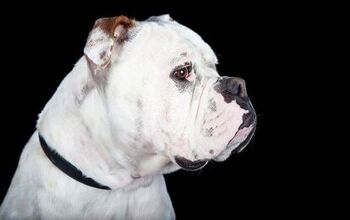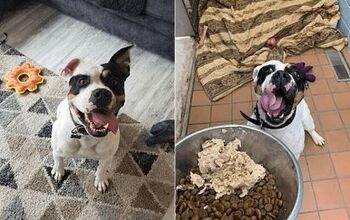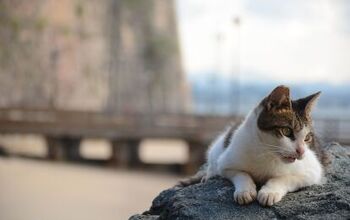Olde English Bulldogge


About Olde English Bulldogge
Olde English Bulldogge Basics
Some people want a new a shiny designer dog. A pup that looks lit and possibly even a little extra to suit their 21st century lifestyle. Other people aren’t so concerned with new and flashy canine aesthetics. They are seeking something a littler more classic. Something old enough that “old” will have to be spelled with an extra “e.” For this special breed of dog owner, there’s only one option. The Olde English Bulldogge is such a classic and old timey designer dog that even the word “dog” comes with an extra “e.” This is the perfect pup to suit anyone with a willfully analogue lifestyle. It goes well with a vinyl, VHS, scotch, and classic paperback collection.
The Olde English Bulldogge is a strong and attractive canine that makes a wonderful family pet. If you are on the lookout for a companion that will love you fiercely and protect you from anyone who looks suspicious, this breed could be the perfect fit. Will this special and compact pup make a perfect match with you and your family? There’s only one way to find out. Keep your eyes glued to this page and scroll away. Everything that you could possibly want to know about the Olde English Bulldogge will be revealed. By the end of this article, you’ll either be racing out to your nearest designer dog breeder or searching for another doggy option.
The Olde English Bulldogge is a cross between a purebred English Bulldog, American Bulldog, American Pit Bull Terrier, and Bullmastiff.
Origin
The Olde English Bulldogge is a designer dog breed from the United States. The origin and the creation of the breed are somewhat unique because the ultimate goal was not to create a new dog breed from scratch, but rather re-create a centuries-old breed. The Olde English Bulldogge was developed by David Leavitt in 1971, who crossed an English Bulldog with an American Bulldog, Pitbull, and Bullmastiff. His goal was to develop a canine that had the looks of the 18th century Bulldog and the personality of the modern English Bulldog. He also wanted to ensure the breed wouldn’t have breathing problems. That’s a complex goal for any dog breeder. Did David Leavitt succeed in his lofty plans? Let’s find out…
Pedigree
The Olde English Bulldogge is a cross between a purebred English Bulldog, American Bulldog, American Pit Bull Terrier, and Bullmastiff. While his ancestry certainly is impressive and doesn’t lack distinction, the Olde English Bulldogge himself is sadly not a recognized breed. In the view of American Kennel Club, crossbreeds are too unpredictable in terms of characteristics to comply with a set of breed standards. Therefore, they are not given the status of breeds in their own right. There is a chance that this many eventually change after enough generations of the Olde English Bulldogges have passed, but that will take many years. It won’t be happening any time soon.
Nevertheless, even if there are no official pedigree papers for your Olde English Bulldogge puppy, you can be certain that your new pet comes from some seriously grand ancestors. Provided that the puppy comes from a reputable breeder who put a lot of effort into developing healthy, exemplary dogs, of course. Backyard breeders and puppy mills often sell sick dogs who experience cruelty from a young age. Never buy Olde English Bulldogge puppies from an unverified breeder. These disreputable business should not be supported or encouraged.
Food / Diet
To ensure your furry companion will be strong, happy, and healthy, stick with feeding him a food that is packed with nutrients and natural ingredients. Most experts agree that dry food for dogs fits that bill- as long as you choose the right kibble. For a dog such as the Olde English Bulldogge, it’s important to pick out premium quality food that’s formulated to meet his unique needs. This would mean kibble suitable for their age (puppy, adult, or senior), size, and activity level. This breed is large and athletic, so they’ll need nutritionally dense kibble to give them fuel! Choose a formula that has real meat as the first ingredient, preferably from a single protein source, followed by healthy fats such as fish oil or flaxseed to contribute omega-3 fatty acids to the mix, complex carbs to fuel your dog, and an array of all-important vitamins and minerals. Avoid kibble that’s not nutritionally rich and wholesome, such as formulas that include artificial ingredients, cheap fillers (such as soy, corn, wheat, meat meal, etc) and even harmful ingredients such as propylene glycol, carrageenan, or corn syrup – to name a few.
You can feed your Olde English Bulldogge 3.5 cups of a high quality dry dog food every day or the amount kibble manufacturer recommends, but split this amount up into multiple servings. This will prevent your pet from snarfing down their daily dose of kibble in just a few swallows- which could cause bloat and digestion issues. Additionally, sticking to a routine and following serving size will reduce your pet’s chances of becoming obese. Obesity is a serious issue for these dogs, as it will bring about a myriad of health issues, starting with the bone system.
If you are in any way concerned about established or altering the diet of your Olde English Bulldogge, then it’s always to check in with your veterinarian. While pet blogs and dog food manufacturers provide useful feeding guidelines, they are still guidelines and should not be treated as gospel. All dogs are different after all, each with their own needs. The only person qualified to assess the specific dietary needs of your personal pup is their vet. So always check in with a vet before making any changes to your pup’s diets for the best and safest results.
The Olde English Bulldogge is known for being protective, capable, fearless, and determined.
Training
The Olde English Bulldogge is a smart dog that is easy to train, but it is important to establish yourself as the pack leader during your training sessions, as these dogs can be independent. You will need to be positive, firm, and confident in your approach, but without being harsh. Aversive training techniques are not only counterproductive, but they can damage the relationship you have with your dog. Instead, rely on reward-based training that uses praise and treats as motivation. A promise of their favorite yummies is sure to get your Olde English Bulldogge excited about training!
Usually, pet owners start with the essentials such as housebreaking, basic commands, teaching a puppy to walk on a leash and socialization. It’s important to start as early as possible, while your dog is still young and not set in its own ways. And they probably will be since the Olde English Bulldogge can have a stubborn streak. So, make sure not to waste those early and impressionable puppy years and start training as early as possible. It will pay off in the long run.
Needless to say, socialization is as important as basic training – you want your pooch to know where to go potty, sure, but you also want them to be calm and friendly with children, strangers, or other animals. Start exposing your Olde English Bulldogge to different situations, environments, and new faces while they are young, so they grow up to be friendly and laid-back.
Weight
A large-sized breed, the Olde English Bulldogge weighs between 50 and 80 pounds. These doggos can grow quite bulky and chubby, so be prepared to save some extra space for them. They can take up a lot of room on the sofa or the armchair, which means you’ll have to share! Of course, being a large breed, the Olde English Bulldogge will need to exercise a lot in order to stay in shape, and won’t do well being cooped up in small places. A tiny apartment or a tiny home might not be ideal for these dogs. Also, it’s worth remembering that despite their size, these dogs can become quite chubby if not given enough exercise. They might seem a bit snoozy and lazy all the time, but you need to nudge them into action and keep everything in order. Of course, a balanced diet is also necessary – no overindulging your pooch with too many treats!
Temperament / Behavior
This breed is known for being protective, capable, fearless, and determined. On the other hand, these dogs are also described as docile, friendly, and affectionate. They are not at all aggressive or aloof- quite the contrary. An Olde English Bulldogge will always want to be by his owner side, and will be more than up to for a session of ear scratches and belly rubs. Plus, they are eager to please, making them fantastic family pets. They are guaranteed to put a smile on the face of every member of your family. It’s practically impossible not to experience joy in the presence of an Olde English Bulldoge.
Unless socialized on time, these hybrid dogs might have a high prey drive, so keeping them with small pets is not the best choice. For the same reason, you should always keep them on a leash when walking in an unsecured area. They could go after a bird or a squirrel in a second. So always keep an eye on your Olde English Bulldogge anytime your in a public place filled with little furry animals to avoid any unfortunate issues.
In addition to being alert and confident, this breed also has the agility and drive to perform in various work roles. They love their family, and they are not afraid to protect their loved ones from anyone who appears threatening, so they make good watchdogs. These pups will always make sure that their humans are safe and happy.
In general, these dogs make great household pets and a loving part of the family. When brought up properly, they will be surprisingly gentle and caring around children, and fiercely devoted to the family. Of course, their goofs and quirky daily habits won’t fail to leave you endlessly amused. Best of all, they will have that inherent desire to protect and guard. It’s that classic English hardy spirit – good natured and resilient!
Common Health Problems
Like other hybrid canine breeds, the Olde English Bulldogge might be susceptible to the health problems that most commonly affect its parent breeds. However, there is no way to predict an individual dog’s long-term health, and there is no guarantee that your dog will inherit any problems. The best that you can do is purchase your dog from a reputable breeder who can prove the health of the parents. Then keep an eye out for symptoms and work closely with your vet to give your pet the best care.
Hybrid breeds like the Olde English Bulldogge are surprisingly hardy and healthy. A couple of the health problems that this breed might be susceptible to include bloat and hip dysplasia. Hip dysplasia is an inherited condition that sadly has no cure, but its symptoms can be helped with veterinary treatment. It is inherited from one of the parent breeds and results in the wear of hip joints. As a result, your pet might experience pain and discomfort. As always, make sure to maintain regularly scheduled checkups with your vet (especially as your dog ages into it’s senior years) so that any potential health issues can be identified and treated as early as possible.
As for acquired diseases that are not necessarily related to the Olde English Bulldogge’s genetics, keep an eye out for obesity, as these dogs have a voracious appetite and a tendency to easily gain extra weight. Needless to say, this can be quite detrimental for their overall health, as obesity contributes to various health issues, from cardiac problems to diabetes and joint and hip problems. Keep your pet lean and fit and you can hope to avoid many of these serious conditions in the long run!
Life Expectancy
The Olde English Bulldogge has an average lifespan of 11 or more years. When seen in general terms, this is quite a good life expectancy for dogs. With a generally accepted maximum being around 15 to 16 years for most dog breeds, 11 years is quite a good lifespan. This means that your Bulldogge friend will be around for quite a while, and you will be able to create some wonderful memories together.
Exercise Requirements
This breed is agile, athletic, and strong, and these dogs can be active when they are conditioned properly. With training and playtime, you can release your pet’s energy in a positive way, but moderate and light exercise should be sufficient. They will be tuckered out without too much effort from their owner.
Make it a point to prevent your pet from exercising in temperatures that are too cold or too hot. These pups are highly sensitive to changes in temperature. They do best in moderate climates. And because these dogs enjoy walking, you can take your pet on a couple of daily walks, or let him run around off-leash in your backyard or at the dog park.
Keep in mind that these dogs like to chew a lot, so you should give your pooch a variety of bones and toys that are safe to chew. Giving your pet plenty of toys to play with while spending time indoors will also keep him mentally stimulated so boredom won’t lead to unwanted behaviors. These dogs will chew on something, so it’s best to give them something to chew on rather than letting them find random objects in your house to satiate their chewing needs.
Like most Bulldog breeds, this one too is susceptible to obesity. You will need to ensure that they get plenty of activity throughout the day, in order for them to burn all those extra calories. That way they can remain strong and muscular rather than chubby! As this breed has relatively shorter legs than usual, obesity can affect it rather badly. Arthritis, joint wear, and difficulty breathing are just some of the things that can arise from extra weight.
The Olde English Bulldogge is eager to please, making them fantastic family pets.
Recognized Clubs
The Olde English Bulldogge is not recognized by the American Kennel Club, as it is considered to be a hybrid breed. However, this breed is recognized by the American Canine Association Inc. (ACA), the American Pet Registry, Inc. (APRI), the Backwoods Bulldog Club (BBC), the Continental Kennel Club (CKC), the Dog Registry of America, Inc. (DRA), the International Olde English Bulldogge Association (IOEBA), the National Kennel Club (NKC), the Olde English Bulldogge Kennel Club (OEBKC), the Olde English Bulldogge Association (OEBA), and the United Kennel Club (UKC).
Coat
If you’ve always wanted a low-maintenance dog that won’t need regular visits to the grooming salon or shed their body weight in hair on a weekly basis, you’re in luck. These designer dogs are as undemanding as it gets when it comes to their beauty regime! Your Olde English Bulldogge will have a short and shiny coat, which means it won’t mat or tangle, nor need to be trimmed and clipped. These dogs shed an average amount, so a minimal amount of grooming is required. Brush your dog at least weekly to keep the shedding under control and keep the fur smooth and clean.
Of course, an important part of coat care and general hygiene is to make sure your pet is clean – don’t neglect regular baths! As a rule of thumb, a dog with a coat type like the Olde English Bulldogge has should be bathed every two to three months, or more frequently if need be – in other words, if they manage to get themselves into a stinky mess in between their regular baths. Bathing them too often could dry out their skin and cause iritations, and skipping on baths makes for one smelly pooch, so try to create a routine you can stick to.
Puppies
As is the case with all puppies, provide your Olde English Bulldogge with a safe and clean environment in which he can grow, learn, and play. Supervise playtime with young children or with larger dogs to ensure your puppy won’t get hurt, as he will be small and delicate. Also, to prevent injuries, keep your puppy from jumping or from engaging in hard exercises until he’s old enough.
It is important to start training your Olde English Bulldogge as soon as possible. Proper obedience training and socialization will ensure your dog will respect your authority and will learn the rules of the house in no time. Most people start with some simple, basic commands around the 8 week mark and short training sessions that last a few minutes in one go, before progressing to things such as potty training when the puppy is between 12 and 16 weeks old. As they grow and develop, you can move on to more and more complex things and longer training sessions.
Of course, it is necessary to have your dog socialized early on. This means that you will need to introduce them to other friendly dogs and strangers too. In the long run, this ensures that your pet will behave properly later down the road, and won’t develop some behavioral issues. Olde English Bulldogges can become quite willful if left to their own devices, so it is best to start training early on.
Photo credit: Joselito Tagarao/Flickr; Rica Ward/Flickr; dnsphotography/Bigstock

Lisa Selvaggio is a freelance writer and editor, and our resident cats-pert, with certifications in pet nutrition and pet first aid. She enjoys producing content that helps people understand animals better so they can give their pets a safe and happy home.
More by Lisa Selvaggio

























